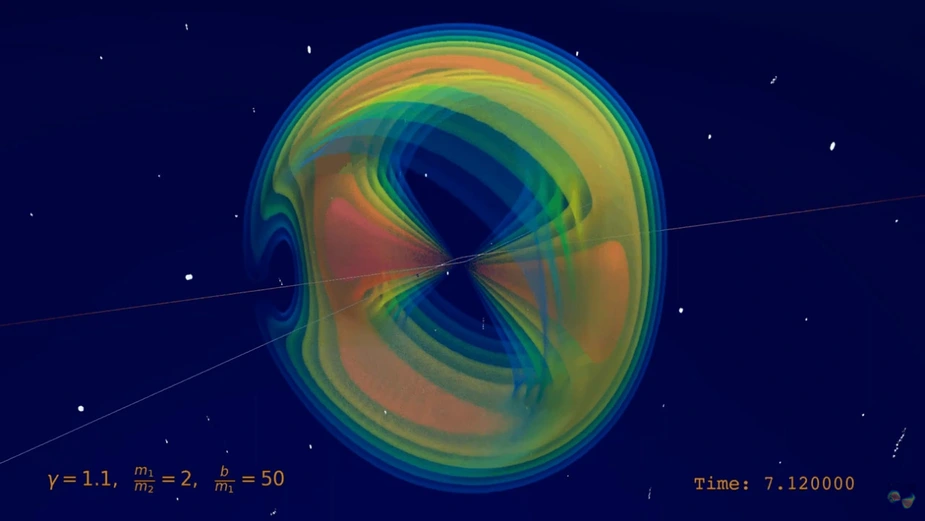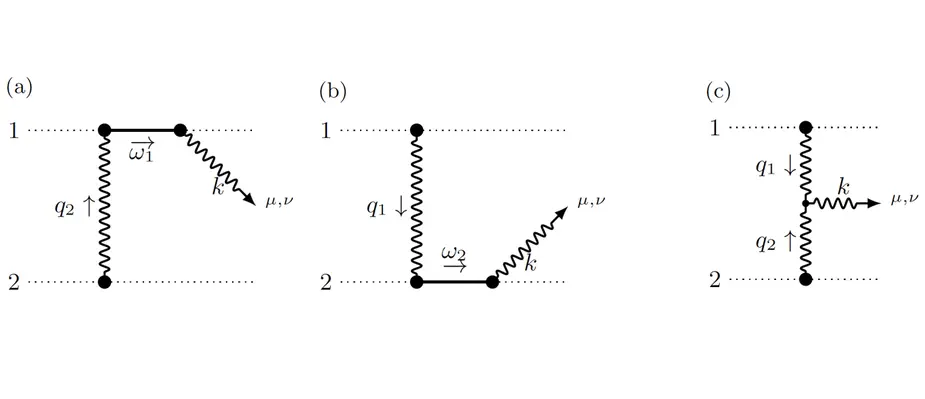Bremsstrahlung of black holes and neutron stars from quantum field theory
Physicians developed a new approach to determining gravitational waves
When two massive objects (black holes, neutron stars, or stars) fly past each other, the gravitational interactions not only deflect their orbits, but also produce gravitational radiation, or gravitational bremsstrahlung, analogous to electromagnetism. The resulting gravitational waves of such a scattering event were calculated at leading order in Newton's gravitational constant in the 1970s using traditional methods of general relativity in an extensive series of four papers. Bremsstrahlung events are still out of reach for the current generation of gravitational-wave detectors because the signal is non-periodic and typically less intense. Nevertheless, they are interesting targets for future searches with future terrestrial and space-based observatories.
In the Quantum Field Theory lab around IRIS Adlerhof-member Prof. Plefka, a new approach to determining these waveforms (Fig. 1) and the deflections using methods of perturbative quantum field theory was recently developed, which proves to be significantly more efficient than the traditional approaches. It is based on a hybrid quantum field theory, in which the black holes (or stars) are idealized as point particles and interact with the gravitational field. The calculation is then based on a systematic diagrammatic expansion using Feynman graphs. I.e. the methods that were originally developed for the scattering of elementary particles can now also be used in astrophysical scenarios.
With this innovative method — the "Worldline Quantum Field Theory“ approach — our understanding of this fundamental physical process was recently significantly extended resulting in a series of three publications in the Physical Review Letters. In [1], the results from the 1970s were reproduced in a far more efficient way; this only required the calculation of three Feynman graphs (Fig. 2). In [2] the waveform could be extended to the case of rotating black holes and neutron stars. In a recent publication [3], the scattering angles and deflections in momenta and rotations due to the scattering process at the next-next-leading order of the gravitational constant were determined for the first time. Elaborated techniques for calculating Feynman integrals were used here. Interestingly, the rotational degrees of freedom of the black holes are described in this new formulation with a supersymmetric world line theory [4], which was originally developed in extensions of the Standard Model of particle physics.
This research was performed in the context of the DFG Research Training Group 2575 "Rethinking Quantum Field Theory“, where innovations in quantum field theory are developed in cooperation with the Max-Planck Institute for Gravitational Physics and the Helmholtz-Centre DESY.
Publications:
[1] Classical Gravitational Bremsstrahlung from a Worldline Quantum Field Theory
G. U. Jakobsen, G. Mogull, J. Plefka, and J. Steinhoff
Phys. Rev. Lett. 126 (2021) 201103
arxiv: 2101.12688
[2] Gravitational Bremsstrahlung and Hidden Supersymmetry of Spinning Bodies
G. U. Jakobsen, G. Mogull, J. Plefka, and J. Steinhoff
Phys. Rev. Lett. 128 (2022) 011101
arxiv: 2106.10256
[3] Conservative and radiative dynamics of spinning bodies at third post-Minkowskian order using worldline quantum field theory
G. U. Jakobsen and G. Mogull
erscheint in PRL
arxiv: 2201.07778
[4] SUSY in the sky with gravitons
G. U. Jakobsen, G. Mogull, J. Plefka, and J. Steinhoff
JHEP 2201 (2022) 027
arxiv: 2109.04465
Further information:
- Videos of the scattering process on Youtube (from BSc thesis of O. Babayemi)
Contact:
Prof. Dr. Jan Plefka
Spokesperson RTG2575 „Rethinking Quantum Field Theory“
Dept. of Physics & IRIS Adlershof, Group Quantumfield- and Stringtheory
Email: jan.plefka(at)hu-berlin.de
Phone: +49 30 2093-66409
Secr.: +49 30 2093-66413
qft.physik.hu-berlin.de
www2.hu-berlin.de/rtg2575/
Released by IRIS Adlershof, 4. March 2022

